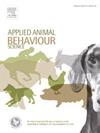Behavioural and physiological indicators of hoof trimming stress in restrained juvenile stable- and forest-born Konik Polski horses: A cross-sectional and longitudinal field study
IF 2.2
2区 农林科学
Q1 AGRICULTURE, DAIRY & ANIMAL SCIENCE
引用次数: 0
Abstract
Behavioural and physiological responses are suggested indicators of horse stress. The responses can vary according to changing intrinsic factors, for example, age or habituation to human handling and restraint.
In this study, the same 53 Konik Polski horses that were born in either a forest-born (FB) sanctuary or a stable-born (SB) sanctuary were assessed for consistency in their behavioural and physiological responses over months, and the relationship between avoidance behaviour (withdrawals, head shakings, jerks, rearings, stepping and their total: AB), leaning behaviour and cardiac responses (heart rate: HR and heart rate variability HRV: SDRR and RMSSD during routine hoof trimming at 6, 12 and 18 months of age was examined. Additionally, the effect of age and birthplace on avoidance behaviour and cardiac parameters and their correlations was investigated.
The avoidance behaviour, leaning behaviour and HR and HRV parameters differed between SB and FB horses (P < 0.01). A significant effect of increasing age/habituation was found in each birth-place group at each age (both effects P < 0.01). Additionally, the correlations of and between behaviour and cardiac parameters were fairly consistent both over age and within groups. The findings indicate that physiological and behavioural markers that are frequently used may not adequately represent the stress status of restrained horses; rather, they may only represent the animals' short-term, current state. Age and prior experience are significant factors to consider when evaluating stress related to husbandry management procedures. Providing that the differences between forest and stable horses remain until 18 months old, the rearing conditions up to weaning would seem sufficient to develop a specific human reception in young horses.
求助全文
约1分钟内获得全文
求助全文
来源期刊

Applied Animal Behaviour Science
农林科学-行为科学
CiteScore
4.40
自引率
21.70%
发文量
191
审稿时长
18.1 weeks
期刊介绍:
This journal publishes relevant information on the behaviour of domesticated and utilized animals.
Topics covered include:
-Behaviour of farm, zoo and laboratory animals in relation to animal management and welfare
-Behaviour of companion animals in relation to behavioural problems, for example, in relation to the training of dogs for different purposes, in relation to behavioural problems
-Studies of the behaviour of wild animals when these studies are relevant from an applied perspective, for example in relation to wildlife management, pest management or nature conservation
-Methodological studies within relevant fields
The principal subjects are farm, companion and laboratory animals, including, of course, poultry. The journal also deals with the following animal subjects:
-Those involved in any farming system, e.g. deer, rabbits and fur-bearing animals
-Those in ANY form of confinement, e.g. zoos, safari parks and other forms of display
-Feral animals, and any animal species which impinge on farming operations, e.g. as causes of loss or damage
-Species used for hunting, recreation etc. may also be considered as acceptable subjects in some instances
-Laboratory animals, if the material relates to their behavioural requirements
 求助内容:
求助内容: 应助结果提醒方式:
应助结果提醒方式:


